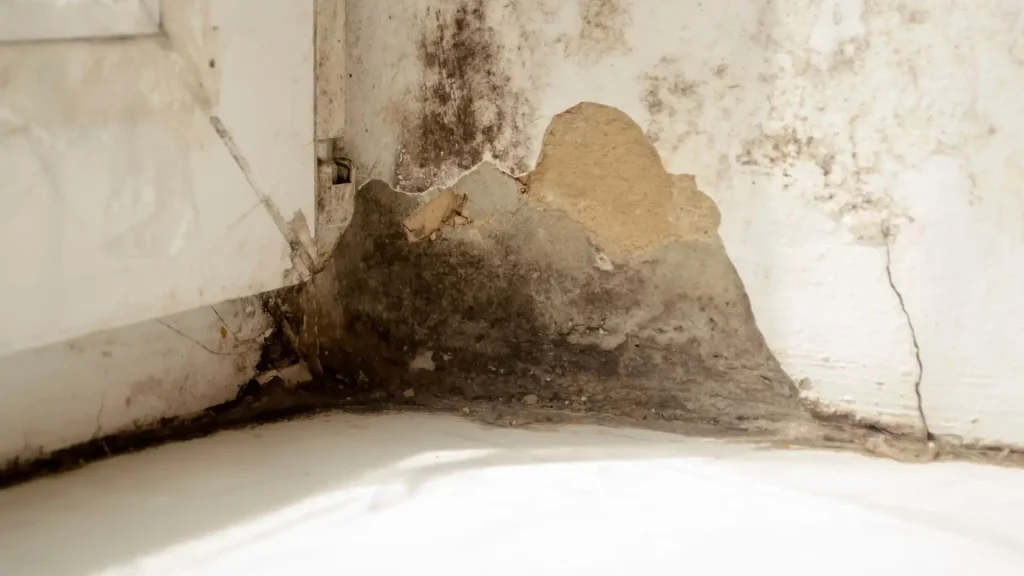Mold growth on painted walls is a common issue, especially in areas with high humidity, such as bathrooms, kitchens, and basements. Mold not only looks unsightly but can also cause health problems, especially for those with allergies or respiratory issues. Fortunately, removing mold from painted walls doesn’t have to be a daunting task. With the right methods, you can effectively clean your walls without damaging the paint, and even take steps to prevent mold from returning.
In this guide, we’ll walk you through the most effective ways to remove mold from painted walls, including the use of common household items like vinegar and bleach. We’ll also explore how to safely repaint walls after mold removal and provide tips to keep your walls mold-free in the future. Whether you’re dealing with a small patch of mold or a more widespread issue, this article will equip you with the knowledge you need to tackle the problem head-on.
-> Interior wall painting projects
How to remove mould from walls without damaging paint?
Mold can be a persistent and harmful problem on painted walls, but with the right approach, it’s possible to remove it without causing damage to your paint. Here’s a step-by-step guide on how to safely get rid of mold on painted walls.
Before you start, make sure you have the necessary supplies:
- Protective gear: gloves, mask, and goggles
- White vinegar or bleach
- Spray bottle
- Soft brush or sponge
- Clean cloths
- Mild detergent
- Warm water
Prepare the area
Start by protecting the surrounding area. Lay down plastic sheets or old towels to catch any drips. Ensure the room is well-ventilated by opening windows and doors, and consider using a fan to improve airflow.
Pour undiluted white vinegar into a spray bottle and apply it directly to the moldy areas. Vinegar is a natural and effective mold killer, and it’s safe for most painted surfaces.
If you prefer, you can use a bleach solution (1 part bleach to 3 parts water). Bleach is powerful at killing mold but should be used cautiously as it can discolor paint.
Spray the chosen solution onto the mold and let it sit for at least 15 minutes to allow it to penetrate and kill the mold spores.
Scrub and clean
Using a soft brush or sponge, gently scrub the moldy areas. Avoid scrubbing too hard, as this can damage the paint. If the mold is stubborn, you may need to apply more cleaning solution and repeat the process.
Rinse and dry
Once the mold is removed, wipe the area with a clean cloth dampened with warm water to remove any remaining cleaning solution. Be sure to dry the wall thoroughly to prevent mold from returning. To prevent mold from returning, reduce moisture in the area by using dehumidifiers, fixing leaks, and ensuring proper ventilation. Regularly inspect your walls and clean them as needed to keep mold at bay.
Is bleach or vinegar better to kill mold?
When it comes to removing mold from painted walls, two of the most commonly recommended solutions are vinegar and bleach. Both are effective, but they work in slightly different ways and have their own pros and cons.
Does vinegar remove mold from painted walls?
Vinegar is a popular choice for mold removal because it is natural, non-toxic, and safe to use on most surfaces, including painted walls. How to remove mold from painted walls with vinegar? Here’s why vinegar might be the best option for you:
- Effectiveness: Vinegar is mildly acidic, which makes it effective at killing about 82% of mold species. It can penetrate porous surfaces and eliminate mold at the root level, preventing it from coming back.
- Safety: Vinegar is safe to use around children and pets. It doesn’t emit harmful fumes, making it ideal for indoor use.
- Non-damaging: Vinegar is gentle on paint and won’t cause discoloration or damage when used properly.
However, vinegar may not be as effective against more stubborn or widespread mold infestations, and it has a strong smell that some people find unpleasant. The odor usually dissipates as the vinegar dries.
How do you get rid of mold on painted walls with bleach?
Bleach is a stronger and more traditional method for killing mold. It is often used in severe cases where mold has deeply penetrated surfaces.
- Effectiveness: Bleach is a powerful disinfectant that kills nearly all mold species on contact. It’s especially effective on non-porous surfaces, where it can eliminate mold entirely.
- Discoloration: While bleach is effective, it can cause discoloration on painted walls, especially if not diluted properly. It’s essential to test a small area first before applying it broadly.
- Fumes: Bleach emits strong fumes that can be harmful if inhaled in large amounts. Always use bleach in a well-ventilated area and wear protective gear.
Bleach might be overkill for small mold spots, and its fumes can be harsh, especially in poorly ventilated spaces. Additionally, bleach may not penetrate deeply enough into porous surfaces like drywall to kill all the mold spores, leading to regrowth.
Which one should you choose?
If you’re dealing with light to moderate mold growth on interior walls, vinegar is likely your best bet due to its safety, effectiveness, and ease of use. However, if the mold is severe or has spread extensively, bleach might be necessary to thoroughly eliminate the problem.
Always consider the specific situation and the extent of the mold growth when choosing between vinegar and bleach. In some cases, using a combination of both—starting with vinegar and following up with bleach if necessary—might provide the best results.

Repainting moldy walls
After removing mold from your painted walls, you might notice that the paint has been damaged or discolored. In some cases, repainting is necessary to restore the appearance of your walls and to ensure that the mold doesn’t return. Before you start repainting, it’s crucial to ensure that the wall is completely dry and free of any remaining mold.
Even small traces of mold can grow back, potentially ruining your new paint job. After cleaning the mold, wait at least 24 to 48 hours for the wall to dry thoroughly. To prevent mold from returning, apply a mold-resistant primer to the wall. This type of primer is specially formulated to inhibit mold growth, creating a protective barrier between the wall and the new paint. Make sure to cover the entire affected area, and allow the primer to dry according to the manufacturer’s instructions.
When selecting paint, opt for a mold-resistant or mildew-resistant paint, especially if the area is prone to moisture. These paints contain antimicrobial agents that help prevent mold from developing on the surface. For high-moisture areas like bathrooms and kitchens, consider using semi-gloss or satin finishes, as they are more resistant to moisture and easier to clean.
Once the primer is dry, apply your chosen paint to the wall. Depending on the color and type of paint, you may need to apply two coats for full coverage. Be sure to follow the drying times recommended on the paint can, and allow the first coat to dry completely before applying the second. To keep your newly painted walls mold-free, take steps to reduce moisture in the area. This includes using exhaust fans, fixing leaks, and keeping the room well-ventilated. Regularly cleaning the walls and monitoring for any signs of mold can also help maintain a healthy, mold-free environment.
Preventing mold on interior walls
After removing mold and repainting your walls, it’s essential to take preventive measures to ensure the mold doesn’t return. Mold thrives in damp, poorly ventilated environments (bathroom), so controlling moisture is key to keeping your walls mold-free. Here are some long-term solutions to help prevent mold growth on painted walls.
Control humidity levels and improve ventilation
High humidity is one of the main contributors to mold growth. To keep humidity levels in check, consider using a dehumidifier in rooms that are prone to dampness, such as basements, bathrooms, and kitchens. Aim to keep indoor humidity levels below 60%, ideally between 30% and 50%. You can use a hygrometer, an inexpensive device that measures humidity, to monitor levels in your home.
Proper ventilation is crucial in preventing mold. Ensure that your home is well-ventilated, especially in areas like bathrooms and kitchens where moisture tends to accumulate. Use exhaust fans while cooking or showering, and keep windows open whenever possible to allow fresh air to circulate. In basements or other areas without windows, consider installing an air circulation system or using a portable fan to keep the air moving.
Repair leaks and address water damage promptly
Leaky pipes, roofs, and windows can lead to water damage, creating the perfect environment for mold to grow. Regularly inspect your home for any signs of leaks, and repair them as soon as possible. If water damage occurs, clean and dry the affected area immediately to prevent mold from developing. Be especially vigilant in areas that are not frequently used, such as attics, basements, and crawl spaces, as leaks can go unnoticed for long periods.
Use mold-resistant products
When renovating or updating your home, consider using mold-resistant materials. Mold-resistant drywall, paint, and insulation are available and can provide extra protection in moisture-prone areas. Additionally, installing vapor barriers in crawl spaces and basements can help prevent moisture from entering these spaces.
Regularly clean and inspect walls
Even with preventive measures in place, it’s important to regularly clean and inspect your walls for any signs of mold. Wipe down walls with a damp cloth and mild detergent, and pay special attention to areas that are more susceptible to moisture. If you notice any discoloration or musty odors, address the issue immediately before mold has a chance to spread.
In summary: How to get rid of mould on walls permanently?
Dealing with mold on walls can be challenging, but with the right approach, you can effectively remove it and prevent it from coming back. Whether you choose to use vinegar for a natural solution or bleach for a more powerful treatment, ensuring that your walls are mold-free is crucial for maintaining a healthy living environment.
By following up with proper repainting techniques and implementing long-term preventive measures, such as controlling humidity and improving ventilation, you can protect your walls from future mold growth. Regular inspections and prompt attention to any moisture issues will help keep your home safe and your walls looking their best.
Ask for professional help! We are happy to help with exterior wall painting of family houses and vacation homes in the Saint Augustine area!
Call for a free quote! 1(904) 217-9681 – Peter Hando
Source of images: Canva


